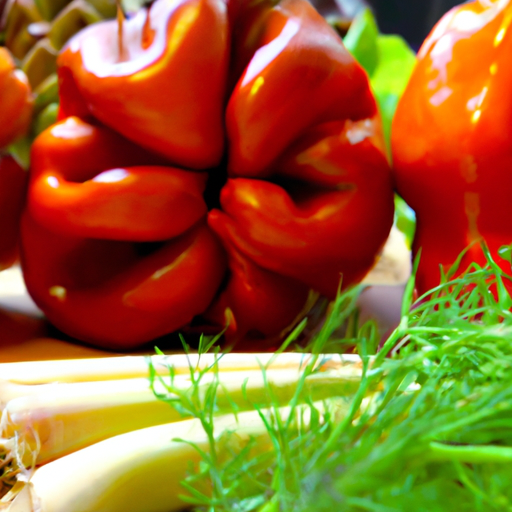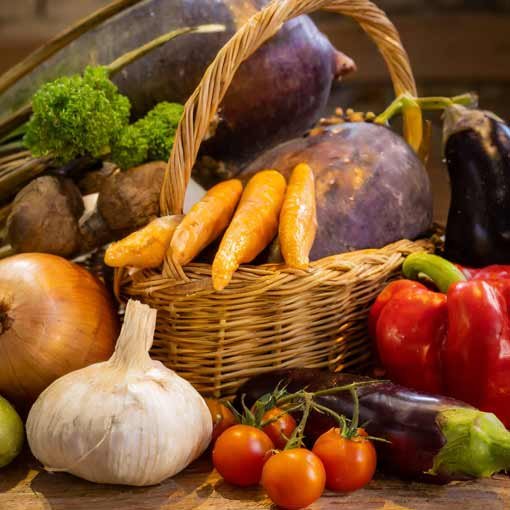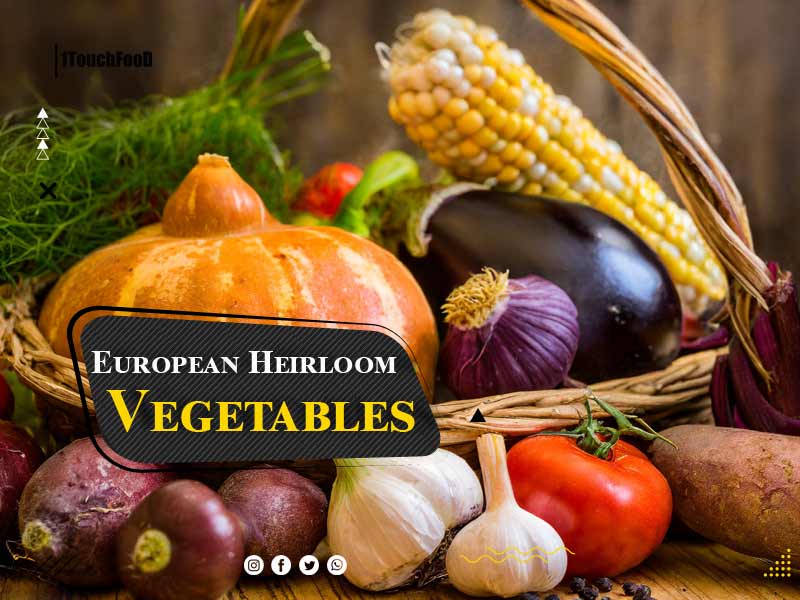5 Must-Try European Heirloom Vegetables for a Taste of History
European heirloom vegetables are not just a delicious addition to any meal, but they also offer a glimpse into the rich history and cultural heritage of the continent. These vegetables have been passed down from generation to generation, carefully preserved and cherished for their unique flavors and characteristics. In recent years, there has been a resurgence of interest in these time-tested treasures, as people seek to reconnect with their roots and discover the diverse and flavorful world of European heirloom vegetables.

If you’re looking to add a touch of history to your plate, here are 5 must-try European heirloom vegetables that are sure to delight your taste buds.
1. Purple Sprouting Broccoli
Purple sprouting broccoli, also known as “PSB,” is a staple in British cuisine and has been grown in the UK since the 18th century. This vegetable is a close relative of regular broccoli, but with a more delicate and sweeter flavor. Its vibrant purple color adds a pop of color to any dish, making it a favorite among chefs and home cooks alike.
What sets purple sprouting broccoli apart is its ability to withstand cold temperatures, making it a popular winter vegetable in Europe. It is typically harvested in late winter or early spring, making it a welcome addition to the dinner table during the colder months. This versatile vegetable can be steamed, roasted, or sautéed, and pairs well with a variety of flavors, making it a must-try for any food enthusiast.
2. Romanesco Cauliflower
Romanesco cauliflower, also known as Romanesco broccoli or Romanesco cabbage, is a unique and visually stunning vegetable that originated in Italy. Its striking appearance, with its bright green color and intricate fractal pattern, has earned it the nickname “broccoflower.”
This vegetable has been around since the 16th century and was a favorite of the Roman nobility. It has a nutty and slightly sweet flavor, making it a popular ingredient in Italian cuisine. Romanesco cauliflower can be enjoyed raw in salads, roasted, or used in soups and stews. Its distinct appearance and flavor make it a must-try for anyone looking to add a touch of Italian heritage to their meals.
3. Ratte Potatoes
Ratte potatoes, also known as fingerling potatoes, are a small and elongated variety that originated in France in the late 19th century. These potatoes have a buttery and nutty flavor, making them a favorite among chefs and foodies. They are also known for their firm and waxy texture, making them perfect for roasting, boiling, or using in salads.
Ratte potatoes are a staple in French cuisine and are often used in dishes such as pommes Anna and gratins. They are also a popular choice for making French fries, as their small size and unique shape make for a crispy and flavorful fry. These potatoes may be small in size, but they pack a big punch in terms of flavor and history.
4. Bull’s Blood Beet
Bull’s blood beet, also known as “Bull’s Blood” or “Bull’s Blood Red,” is a variety of beet that has been grown in Europe since the 19th century. This vegetable gets its name from its deep red color, which resembles the color of a bull’s blood. It has a sweet and earthy flavor, making it a popular ingredient in salads, soups, and stews.
What sets Bull’s Blood beet apart is its versatility in the kitchen. Not only can the root be eaten, but the leaves are also edible and can be used in salads or sautéed as a side dish. This vegetable is not only a delicious addition to any meal, but it also offers a glimpse into the rich agricultural history of Europe.
5. Purple Haze Carrots
Purple Haze carrots, also known as purple carrots, are a variety of carrot that originated in Afghanistan and have been grown in Europe since the 10th century. These carrots have a deep purple color on the outside and a bright orange interior, making them a visually stunning addition to any dish.
Purple Haze carrots have a slightly sweeter and earthier flavor than regular carrots, making them a popular choice for roasting or using in soups and stews. They are also a great source of antioxidants and are packed with nutrients, making them a healthy and delicious choice for any meal.
In conclusion, European heirloom vegetables offer a unique and flavorful experience that connects us to our past and cultural heritage. These 5 must-try vegetables are just a small sample of the diverse and delicious world of European heirloom vegetables. So why not take a trip back in time and rediscover these time-tested treasures for yourself? Your taste buds will thank you.
The Health Benefits of Incorporating European Heirloom Vegetables into Your Diet

European heirloom vegetables have been a staple in traditional European cuisine for centuries. These vegetables, passed down from generation to generation, have stood the test of time and continue to be cherished for their unique flavors and health benefits. In recent years, there has been a resurgence in interest for these time-tested treasures, as people are rediscovering the benefits of incorporating them into their diets.
One of the main reasons for the popularity of European heirloom vegetables is their nutritional value. These vegetables are grown from seeds that have been carefully preserved and passed down for generations, resulting in a diverse range of varieties with high nutrient content. For example, the purple-skinned eggplant, a popular heirloom vegetable in Mediterranean cuisine, is rich in antioxidants and contains high levels of vitamins A and C. Similarly, the bright orange carrots, a staple in many European dishes, are packed with beta-carotene, which is essential for maintaining healthy eyesight and skin.
Moreover, European heirloom vegetables are often grown using traditional farming methods, without the use of pesticides and chemicals. This means that they are free from harmful toxins and retain their natural flavors and nutrients. In contrast, modern farming practices often prioritize quantity over quality, resulting in vegetables that are lacking in nutritional value. By incorporating heirloom vegetables into your diet, you can ensure that you are consuming food that is not only delicious but also beneficial for your health.

In addition to their nutritional value, European heirloom vegetables also offer a wide range of flavors and textures. These vegetables come in a variety of shapes, sizes, and colors, making them a feast for the eyes as well as the taste buds. For instance, the vibrant purple and white striped Chioggia beets, originally from Italy, have a sweet and earthy flavor, while the bright green Romanesco broccoli, a favorite in French cuisine, has a nutty and slightly spicy taste. By incorporating a variety of heirloom vegetables into your diet, you can add depth and complexity to your meals, making them more enjoyable and satisfying.
Furthermore, European heirloom vegetables are often more resilient and adaptable to different growing conditions. This is because they have been cultivated over generations to withstand various environmental factors, such as extreme temperatures and pests. As a result, they are more likely to thrive in different climates and require less maintenance, making them a sustainable and cost-effective option for home gardeners. By growing your own heirloom vegetables, you can have a constant supply of fresh and nutritious produce at your fingertips.
Aside from their nutritional and culinary benefits, European heirloom vegetables also have a rich cultural significance. These vegetables are deeply rooted in the history and traditions of European countries, and their cultivation and consumption are often tied to cultural celebrations and rituals. For example, the bright red and white striped Bull’s Blood beets, a popular heirloom vegetable in Poland, are traditionally eaten on Christmas Eve as part of the Wigilia feast. By incorporating these vegetables into your diet, you are not only nourishing your body but also connecting with the cultural heritage of these countries.
In conclusion, European heirloom vegetables offer a multitude of health benefits, from their high nutrient content to their diverse flavors and cultural significance. By incorporating these time-tested treasures into your diet, you can not only improve your overall health but also add a touch of tradition and culture to your meals. So why not take a trip down memory lane and rediscover the joys of European heirloom vegetables? Your taste buds and body will thank you.
Preserving Tradition: How European Heirloom Vegetables are Keeping Culinary Heritage Alive
European cuisine is known for its rich and diverse flavors, with each country having its own unique culinary traditions. These traditions have been passed down from generation to generation, and one of the key elements that have helped preserve them are heirloom vegetables. These time-tested treasures have been a staple in European cooking for centuries, and their importance in preserving culinary heritage cannot be overstated.
Heirloom vegetables are varieties that have been passed down through families and communities for at least 50 years. They are open-pollinated, meaning they are pollinated by natural means such as wind, insects, or birds, and their seeds can be saved and replanted year after year. This is in contrast to hybrid vegetables, which are created by cross-breeding different varieties and do not produce seeds that can be saved for future planting.

One of the main reasons why heirloom vegetables are so important in preserving culinary heritage is their unique and distinct flavors. These vegetables have been carefully selected and cultivated over generations, resulting in a depth of flavor that cannot be replicated by modern hybrid varieties. For example, the Brandywine tomato, a popular heirloom variety, is known for its rich, sweet, and tangy flavor that is unmatched by any other tomato variety.
In addition to their flavors, heirloom vegetables also play a crucial role in preserving traditional cooking methods. Many European dishes have been passed down for centuries, and the use of heirloom vegetables is an integral part of these recipes. For instance, the Italian dish, Caponata, is traditionally made with heirloom eggplants, which give the dish its distinct flavor and texture. By using these vegetables, cooks are able to recreate the authentic taste of traditional dishes, keeping the culinary heritage alive.
Moreover, heirloom vegetables are deeply rooted in cultural and historical significance. Many of these varieties have been grown in Europe for centuries and have become an integral part of the local culture. For example, the Ratte potato, a small fingerling potato with a buttery and nutty flavor, has been grown in France since the 19th century and is considered a national treasure. These vegetables not only provide a connection to the past but also serve as a reminder of the importance of preserving cultural traditions.
In recent years, there has been a resurgence of interest in heirloom vegetables, with many chefs and home cooks rediscovering these time-tested treasures. This renewed interest has led to the conservation and preservation of many heirloom varieties that were on the brink of extinction. Organizations such as Slow Food and Seed Savers Exchange have been instrumental in promoting and preserving heirloom vegetables, ensuring that they continue to be a part of our culinary heritage.
Furthermore, the use of heirloom vegetables also promotes sustainable and environmentally friendly farming practices. These vegetables are often grown using traditional methods, without the use of synthetic fertilizers and pesticides. This not only results in healthier and more flavorful produce but also helps to preserve the biodiversity of our food system. By supporting the cultivation of heirloom vegetables, we are also supporting small-scale farmers and promoting sustainable agriculture.
In conclusion, heirloom vegetables are more than just a delicious addition to our meals. They are a vital part of preserving European culinary heritage, with their unique flavors, traditional cooking methods, cultural significance, and sustainable farming practices. As we continue to rediscover and appreciate these time-tested treasures, we are not only preserving the past but also ensuring that these heirloom varieties will continue to be a part of our future.
Q&A
1) What are Time-Tested Treasures?
Time-Tested Treasures are European heirloom vegetables that have been cultivated and passed down through generations, often for hundreds of years. These vegetables have stood the test of time and are known for their unique flavors, nutritional value, and adaptability to different growing conditions.
2) Why are these heirloom vegetables considered treasures?
These heirloom vegetables are considered treasures because they have been carefully preserved and passed down through generations, often by small-scale farmers and gardeners. They offer a taste of history and cultural heritage, and their unique characteristics make them valuable additions to any garden or kitchen.
3) How can one rediscover European heirloom vegetables?
One can rediscover European heirloom vegetables by seeking out seed catalogs and specialty nurseries that offer a variety of heirloom seeds. Additionally, attending local farmers markets and talking to small-scale farmers and gardeners can provide valuable information and access to these time-tested treasures.
Conclusion
In conclusion, Time-Tested Treasures: Rediscovering European heirloom vegetables is a valuable resource for anyone interested in exploring the rich history and diverse flavors of European heirloom vegetables. This book not only provides a comprehensive guide to these traditional varieties, but also highlights the importance of preserving and celebrating these time-tested treasures for future generations. With its beautiful illustrations and informative content, this book is a must-have for any gardener, cook, or food enthusiast looking to expand their knowledge and palate.
Rediscovering these heirloom vegetables not only adds variety to our diets, but also helps to preserve cultural heritage and promote biodiversity in our food systems. Overall, Time-Tested Treasures is a fascinating and informative read that will inspire readers to incorporate these unique and flavorful vegetables into their own gardens and kitchens.
Please follow us on linkedin. You can learn all best canadian food recipes you can check our Culinary 1TouchFood Youtube and Telegram 1TouchFood page. Don’t forget Fighting Obesity Magazine and Radio Cooking.

